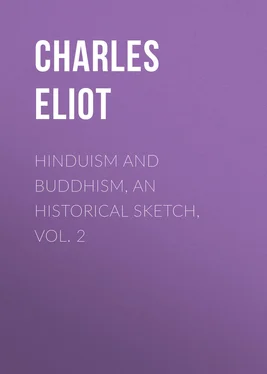Charles Eliot - Hinduism and Buddhism, An Historical Sketch, Vol. 2
Здесь есть возможность читать онлайн «Charles Eliot - Hinduism and Buddhism, An Historical Sketch, Vol. 2» — ознакомительный отрывок электронной книги совершенно бесплатно, а после прочтения отрывка купить полную версию. В некоторых случаях можно слушать аудио, скачать через торрент в формате fb2 и присутствует краткое содержание. Жанр: foreign_religion, Философия, Религиозная литература, foreign_psychology, foreign_antique, foreign_prose, на английском языке. Описание произведения, (предисловие) а так же отзывы посетителей доступны на портале библиотеки ЛибКат.
- Название:Hinduism and Buddhism, An Historical Sketch, Vol. 2
- Автор:
- Жанр:
- Год:неизвестен
- ISBN:нет данных
- Рейтинг книги:4 / 5. Голосов: 1
-
Избранное:Добавить в избранное
- Отзывы:
-
Ваша оценка:
- 80
- 1
- 2
- 3
- 4
- 5
Hinduism and Buddhism, An Historical Sketch, Vol. 2: краткое содержание, описание и аннотация
Предлагаем к чтению аннотацию, описание, краткое содержание или предисловие (зависит от того, что написал сам автор книги «Hinduism and Buddhism, An Historical Sketch, Vol. 2»). Если вы не нашли необходимую информацию о книге — напишите в комментариях, мы постараемся отыскать её.
Hinduism and Buddhism, An Historical Sketch, Vol. 2 — читать онлайн ознакомительный отрывок
Ниже представлен текст книги, разбитый по страницам. Система сохранения места последней прочитанной страницы, позволяет с удобством читать онлайн бесплатно книгу «Hinduism and Buddhism, An Historical Sketch, Vol. 2», без необходимости каждый раз заново искать на чём Вы остановились. Поставьте закладку, и сможете в любой момент перейти на страницу, на которой закончили чтение.
Интервал:
Закладка:
186
For the resemblances to Nâgârjuna see J.R.A.S. 1910, pp. 136 ff. Especially remarkable are II. 32 na nirodho na cotpattir, etc., and IV. 59 and the whole argument that causation is impossible. Noticeable too is the use of Buddhist terms like upâya, nirvâṇa, buddha and âdibuddha, though not always in the Buddhist sense.
187
The uncertainty as to the date of Kanishka naturally makes it uncertain whether he was the hero of these conquests. Kashmir was certainly included in the dominions of the Kushans and was a favourite residence of Kanishka. About 90 A.D. a Kushan king attacked Central Asia but was repulsed by the Chinese general Pan-Ch'ao. Later, after the death of Pan-Ch'ao (perhaps about 103 A.D.), he renewed the attempt and conquered Kashgar, Yarkand and Khotan. See Vincent Smith, Early History of India , 3rd ed. pp. 253 ff.
188
See Fa-Hsien, ed. Legge, p. 33, B.E.F.E.O. 1903 (Sung Yün), pp. 420 ff. Watters, Yüan Chwang , I. pp. 204 ff. J.R.A.S. 1909, p. 1056, 1912, p. 114. For the general structure of these stûpas see Foucher, L'art Gréco-Bouddhique du Gandhara , pp. 45 ff.
189
J.R.A.S. 1909, p. 1058. "Acaryanam Sarvastivadinam pratigrahẽ."
190
Similarly Harsha became a Buddhist late in life.
191
Watters, vol. I. p. 203. He places Kanishka's accession 400 years after the death of the Buddha, which is one of the arguments for supposing Kanishka to have reigned about 50 B.C., but in another passage (Watters, I. 222, 224) he appears to place it 500 years after the death.
192
Watters, vol. I. 270-1.
193
But Târanâtha says some authorities held that it met at Jalandhara. Some Chinese works say it was held at Kandahar.
194
Walters, l.c.
195
Translated by Takakusu in T'oung Pao , 1904, pp. 269 ff. Paramârtha was a native of Ujjain who arrived at Nanking in 548 and made many translations, but it is quite possible that this life of Vasubandhu is not a translation but original notes of his own.
196
Chinese expressions like "in the five hundred years after the Buddha's death" probably mean the period 400-500 of the era commencing with the Buddha's death and not the period 500-600. The period 1-100 is "the one hundred years," 101-200 "the two hundred years" and so on. See B.E.F.E.O. 1911, 356. But it must be remembered that the date of the Buddha's death is not yet certain. The latest theory (Vincent Smith, 1919) places it in 554 B.C.
197
Chap. XII.
198
See Watters, I. pp. 222, 224 and 270. It is worth noting that Hsüan Chuang says Asoka lived one hundred years after the Buddha's death. See Watters, I. p. 267. See also the note of S. Lévi in J.R.A.S. 1914, pp. 1016-1019, citing traditions to the effect that there were 300 years between Upagupta, the teacher of Asoka, and Kanishka, who is thus made to reign about 31 A.D. On the other hand Kanishka's chaplain Sangharaksha is said to have lived 700 years after the Buddha.
199
See Takakusu in J.P.T.S. 1905, pp. 67 ff. For the Sarvâstivâdin Canon, see my chapter on the Chinese Tripitaka.
200
See above, vol. I. p. 262. For an account of the doctrines see also Vasilief, 245 ff. Rockhill, Life of the Buddha , pp. 190 ff.
201
Its connection with Gandhara and Kashmir is plainly indicated in its own scriptures. See Przyluski's article on "Le Nord-Ouest de l'Inde dans le Vinaya des Mûla-sarvâstivâdins," J.A. 1914, II. pp. 493 ft. This Vinaya must have received considerable additions as time went on and in its present form is posterior to Kanishka.
202
The distinction between Sarvâstivâdin and Mûlasarvâstivâdin is not clear to me. I can only suggest that when a section of the school accepted the Mahâvibhâshâ and were known as Vaibhâshikas others who approved of the school chiefly on account of its excellent Vinaya called themselves Primitive Sarvâstivâdins.
203
See Sylvain Lévi, J.A. 1908, XII. 57 ff., and Winternitz, Ges. Ind. Lit. II. i. pp. 201 ff.
204
The only reason for doubting it is that two stories (Nos. 14 and 31) in the Sûtrâlankâra (which appears to be a genuine work) refer to Kanishka as if he had reigned in the past. This may be a poetic artifice or it may be that the stories are interpolations. See for the traditions Watters on Yüan Chwang , II. 102-4 and Takakusu in J.R.A.S. 1905, p. 53 who quotes the Chinese Samyukta-ratna-piṭaka-sûtra and the Record of Indian Patriarchs. The Chinese list of Patriarchs is compatible with the view that Aśvaghosha was alive about 125 A.D. for he was the twelfth Patriarch and Bodhidharma the twenty-eighth visited China in 520. This gives about 400 years for sixteen Patriarchs, which is possible, for these worthies were long-lived. But the list has little authority.
205
The traditions are conveniently collected in the introduction to Teitaro Suzuki's translation of The Awakening of Faith.
206
The Saundarânandakâvya.
207
See Nanjio, Nos. 1182, 1351, 1250, 1299. It is noticeable that the translator Paramârtha shows a special interest in the life and works of Asanga and Vasubandhu.
208
See Winternitz, Ges. Ind. Lit. II. i. p. 211. It is also noticeable that The Awakening of Faith appears to quote the Lankâvatâra sûtra which is not generally regarded as an early Mahayanist work.
209
Nâgârjuna cannot have been the founder of the Mahayana for in his Mahâ-prajñâ-pâramitâ-śâstra (Nanjio, 1169, translation by Kumârajiva) he cites inter alia the Lotus, the Vimalakirti-sûtra, and a work called Mahâyâna-śâstra. See B.E.F.E.O. 1911, p. 453. For Nâgârjuna see especially Grünwedel, Mythologie , pp. 29 ff. and the bibliography given in the notes. Jour. Budd. Text. Soc. V. part iv. pp. 7 ff. Watters, Yüan Chwang , pp. 200 ff. Târanâtha, chap. XV and Winternitz, Ges. Ind. Lit. II. i. pp. 250 ff.
210
He is omitted from the list of Buddhabhadra, giving the succession according to the Sarvâstivâdins, to which school he did not belong. I-Ching classes him with Aśvaghosha and Aryadeva as belonging to the early period.
211
Râjataranginî, i. 173, 177.
212
Edited in the Bibliotheca Buddhica by De la Vallée Poussin and (in part) in the Journal of the Buddhist Text Soc. See too Walleser, Die Mittlere Lehre des Nâgârjuna nach der Tibetischen Version übertragen , 1911: nach der Chinesischen Version übertragen , 1912.
213
The ascription of these works to Nâgârjuna is probably correct for they were translated by Kumârajîva who was sufficiently near him in date to be in touch with good tradition.
214
The name of this king, variously given as Udayana, Jetaka and Śâtavâhana, has not been identified with certainty from the various transcriptions and translations in the Chinese and Tibetan versions. See J. Pali Text Soc. for 1886 and I-Ching Records of the Buddhist Religion (trans. Takakusu), pp. 158 ff. The Andhra kings who reigned from about 240 B.C. to 225 A.D. all claimed to belong to the Śâtavâhana dynasty. The stupa of Amarâvati in the Andhra territory is surrounded by a stone railing ascribed to the period 160-200 A.D. and Nâgârjuna may have addressed a pious king living about that time.
Читать дальшеИнтервал:
Закладка:
Похожие книги на «Hinduism and Buddhism, An Historical Sketch, Vol. 2»
Представляем Вашему вниманию похожие книги на «Hinduism and Buddhism, An Historical Sketch, Vol. 2» списком для выбора. Мы отобрали схожую по названию и смыслу литературу в надежде предоставить читателям больше вариантов отыскать новые, интересные, ещё непрочитанные произведения.
Обсуждение, отзывы о книге «Hinduism and Buddhism, An Historical Sketch, Vol. 2» и просто собственные мнения читателей. Оставьте ваши комментарии, напишите, что Вы думаете о произведении, его смысле или главных героях. Укажите что конкретно понравилось, а что нет, и почему Вы так считаете.












